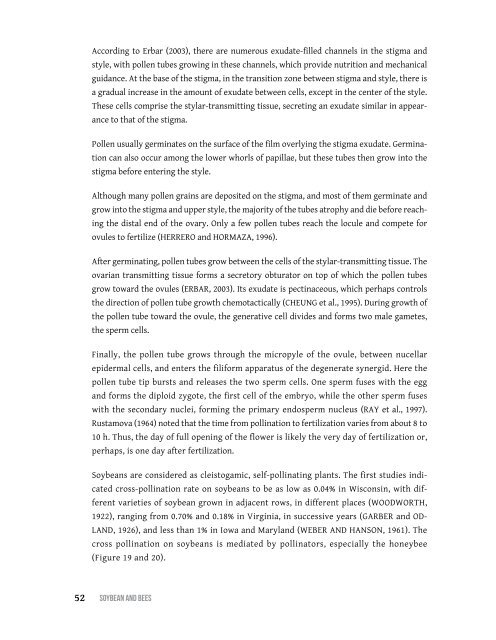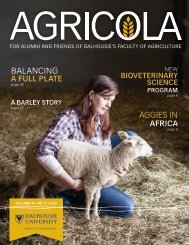SOYBEAN and BEES
BFhV4z
BFhV4z
You also want an ePaper? Increase the reach of your titles
YUMPU automatically turns print PDFs into web optimized ePapers that Google loves.
According to Erbar (2003), there are numerous exudate-filled channels in the stigma <strong>and</strong><br />
style, with pollen tubes growing in these channels, which provide nutrition <strong>and</strong> mechanical<br />
guidance. At the base of the stigma, in the transition zone between stigma <strong>and</strong> style, there is<br />
a gradual increase in the amount of exudate between cells, except in the center of the style.<br />
These cells comprise the stylar-transmitting tissue, secreting an exudate similar in appearance<br />
to that of the stigma.<br />
Pollen usually germinates on the surface of the film overlying the stigma exudate. Germination<br />
can also occur among the lower whorls of papillae, but these tubes then grow into the<br />
stigma before entering the style.<br />
Although many pollen grains are deposited on the stigma, <strong>and</strong> most of them germinate <strong>and</strong><br />
grow into the stigma <strong>and</strong> upper style, the majority of the tubes atrophy <strong>and</strong> die before reaching<br />
the distal end of the ovary. Only a few pollen tubes reach the locule <strong>and</strong> compete for<br />
ovules to fertilize (Herrero <strong>and</strong> Hormaza, 1996).<br />
After germinating, pollen tubes grow between the cells of the stylar-transmitting tissue. The<br />
ovarian transmitting tissue forms a secretory obturator on top of which the pollen tubes<br />
grow toward the ovules (Erbar, 2003). Its exudate is pectinaceous, which perhaps controls<br />
the direction of pollen tube growth chemotactically (Cheung et al., 1995). During growth of<br />
the pollen tube toward the ovule, the generative cell divides <strong>and</strong> forms two male gametes,<br />
the sperm cells.<br />
Finally, the pollen tube grows through the micropyle of the ovule, between nucellar<br />
epidermal cells, <strong>and</strong> enters the filiform apparatus of the degenerate synergid. Here the<br />
pollen tube tip bursts <strong>and</strong> releases the two sperm cells. One sperm fuses with the egg<br />
<strong>and</strong> forms the diploid zygote, the first cell of the embryo, while the other sperm fuses<br />
with the secondary nuclei, forming the primary endosperm nucleus (Ray et al., 1997).<br />
Rustamova (1964) noted that the time from pollination to fertilization varies from about 8 to<br />
10 h. Thus, the day of full opening of the flower is likely the very day of fertilization or,<br />
perhaps, is one day after fertilization.<br />
Soybeans are considered as cleistogamic, self-pollinating plants. The first studies indicated<br />
cross-pollination rate on soybeans to be as low as 0.04% in Wisconsin, with different<br />
varieties of soybean grown in adjacent rows, in different places (Woodworth,<br />
1922), ranging from 0.70% <strong>and</strong> 0.18% in Virginia, in successive years (Garber <strong>and</strong> Odl<strong>and</strong>,<br />
1926), <strong>and</strong> less than 1% in Iowa <strong>and</strong> Maryl<strong>and</strong> (Weber <strong>and</strong> Hanson, 1961). The<br />
cross pollination on soybeans is mediated by pollinators, especially the honeybee<br />
(Figure 19 <strong>and</strong> 20).<br />
52 SoybeAn <strong>and</strong> bees






